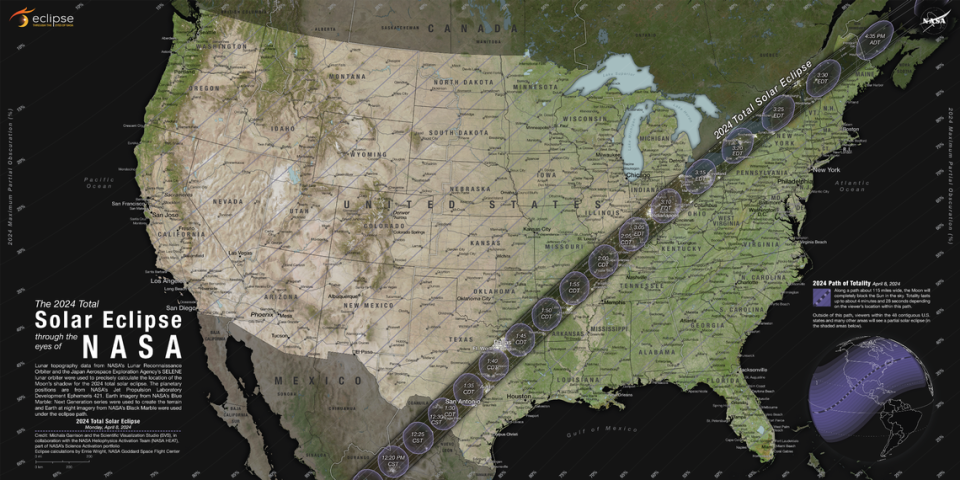Will it be cloudy during the solar eclipse? See the forecast for central Pennsylvania
Finally, April 8’s solar eclipse is almost here. If you’re excited for the big day, you likely already have your glasses ready, your travel plans lined up and maybe even a day off of work to see the total solar eclipse in all its glory.
However, there’s one aspect of planning for the eclipse you can’t control: the weather. An afternoon of overcast skies or rain might keep you from seeing the eclipse as intended and put a damper on the entire event. Although you can’t change the forecast, looking ahead might give you a better sense of what you might see when you look up at the sky April 8.
Here’s what you need to know about Monday’s forecast if you hope to view the eclipse in central Pennsylvania.
Will it be cloudy in central PA during the eclipse April 8?
Cloud cover might dull the impact of a total solar eclipse and reduce its dramatic effect, but changes in daylight should still be noticeable.
State College should see partly cloudy skies Monday, according to AccuWeather’s latest forecast as of Friday afternoon. The agency estimates 87% cloud cover on April 8, suggesting skies will be cloudy more often than clear, especially in the evening.
“Unfortunately, it looks like we’re going to have to contend with some clouds,” AccuWeather senior meteorologist Tom Kines told the Centre Daily Times on Friday. “If it was the perfect world, the clouds would part between about 2 and 4 p.m. and there wouldn’t be any issues. It’s a tough call whether it will be a solid deck of clouds coming in, but I guess there’s still some hope that maybe, at least at times, the sun would be uncovered in that time frame.”
Models from the National Weather Service are a bit optimistic with estimates between 40% and 60% cloud cover for State College during the eclipse. Those models were used in an interactive New York Times tool that allows users to see cloud cover projections for their areas during the eclipse.
Kines said rain is not a big threat for Monday’s forecast, but showers are more likely west of Centre County and can’t be ruled out entirely. However, he expressed optimism that clouds moving from west to east might lighten up by the time they reach the State College area,
“That’s another big question mark. I do think the clouds will be… I don’t want to say dissipating, but perhaps breaking up as they head eastward when they come in from the west,” Kines said. “Certainly, there could be breaks in the clouds. If you bought those glasses, don’t throw them away yet. You still might be able to use them.”
Though still cool, Monday’s high temperature of 59 degrees Fahrenheit in State College should be comfortable enough to keep eclipse watchers outside. Winds in the area — settling at 5 mph with gusts up to 8 mph — should not be much of a bother, either.

Partial obscuration in State College — when any part of the sun is blocked by the moon — will begin at 2:04 p.m. and end at 4:32 p.m., according to eclipse models. Obscuration will peak at 3:20 p.m. when roughly 95.5% of the sun’s surface area is covered by the moon.
AccuWeather has a good grasp on the outlook for cloud cover as April 8’s eclipse approaches, but narrowing expectations for the middle of the afternoon is a challenge.
“It’s very challenging because you’re not talking about the whole day,” Kines said. “You’re talking about roughly a two-hour window, and to be more precise, in that four- or five-minute time frame when the sun is mostly obscured. We could have sunshine all day long, but if there’s a cloud that pops up right during the peak of the eclipse, you’re screwed. You’re talking about a very small window there in the afternoon that most people are concerned about. On a normal day, you’d get away with ‘partly sunny’ or whatever, but that won’t cut it on Monday.”
Staying safe while watching the eclipse
Unless you are viewing a total solar eclipse from the path of totality, where the sun’s light is briefly blocked out entirely by the moon, you need to take precautions to prevent serious eye injury.
Even when the sun is partially obscured, an unprotected look for even a brief moment can result in vision loss or blindness as wavelengths of light damage your retina. The sun’s light can still damage your eyes during an eclipse when it might appear dimmer.
Solar viewing glasses are perhaps the most convenient way to safely view an eclipse. Eclipse glasses are often thousands of times darker than everyday sunglasses and should comply with international safety standards. Visit the American Astronomical Society’s website to find safe and reputable supplies near you.
Glasses from the 2017 total solar eclipse or the 2023 annular eclipse can still work so long as they are in good condition. Otherwise, consider crafting your own pair using materials from around the house.
You could also craft a pinhole projector at home to view an eclipse indirectly. NASA recommends a project in this manner that lets sunlight shine through a hole in a sheet of paper to create a shadow of an eclipse on the ground.

